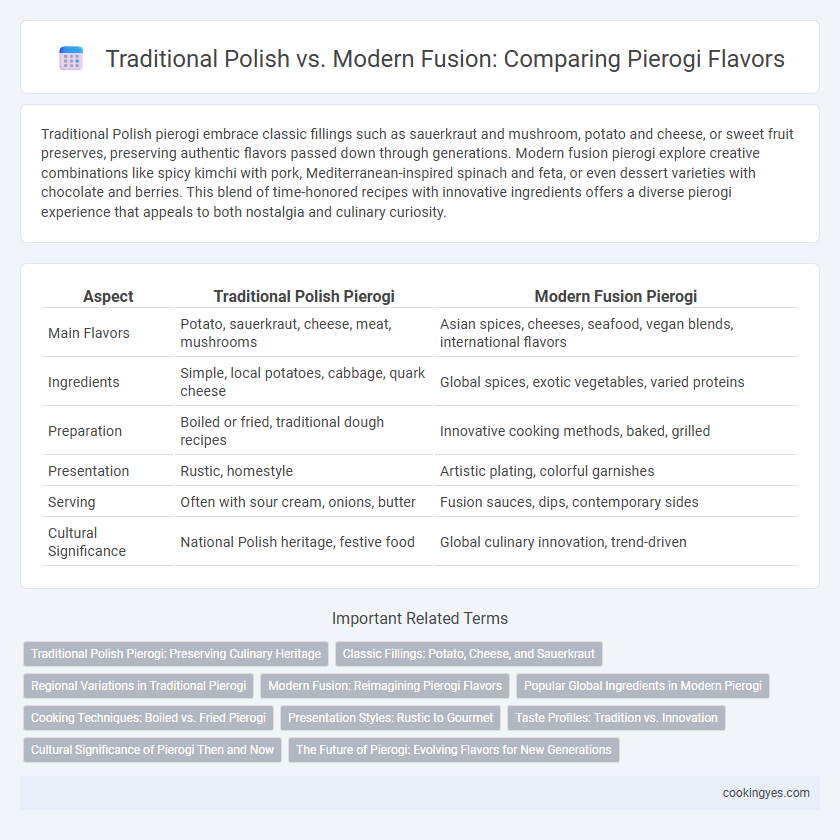Traditional Polish pierogi embrace classic fillings such as sauerkraut and mushroom, potato and cheese, or sweet fruit preserves, preserving authentic flavors passed down through generations. Modern fusion pierogi explore creative combinations like spicy kimchi with pork, Mediterranean-inspired spinach and feta, or even dessert varieties with chocolate and berries. This blend of time-honored recipes with innovative ingredients offers a diverse pierogi experience that appeals to both nostalgia and culinary curiosity.
Table of Comparison
| Aspect | Traditional Polish Pierogi | Modern Fusion Pierogi |
|---|---|---|
| Main Flavors | Potato, sauerkraut, cheese, meat, mushrooms | Asian spices, cheeses, seafood, vegan blends, international flavors |
| Ingredients | Simple, local potatoes, cabbage, quark cheese | Global spices, exotic vegetables, varied proteins |
| Preparation | Boiled or fried, traditional dough recipes | Innovative cooking methods, baked, grilled |
| Presentation | Rustic, homestyle | Artistic plating, colorful garnishes |
| Serving | Often with sour cream, onions, butter | Fusion sauces, dips, contemporary sides |
| Cultural Significance | National Polish heritage, festive food | Global culinary innovation, trend-driven |
Traditional Polish Pierogi: Preserving Culinary Heritage
Traditional Polish pierogi emphasize preserving culinary heritage by using classic fillings such as sauerkraut and mushrooms, potato and cheese, or meat. These recipes honor time-tested techniques passed down through generations, maintaining authentic textures and flavors. Traditional pierogi are often handmade with locally sourced ingredients, reflecting Poland's rich cultural history and regional diversity.
Classic Fillings: Potato, Cheese, and Sauerkraut
Traditional Polish pierogi feature classic fillings like potato, cheese, and sauerkraut, highlighting regional ingredients and recipes passed down through generations. Modern fusion pierogi experiment with bold, unconventional flavors while maintaining the essence of these classic bases, blending cultural influences and innovative cooking techniques. Potato and cheese fillings provide a creamy texture, while sauerkraut adds a tangy contrast, both staple tastes that anchor pierogi's heritage amid contemporary adaptations.
Regional Variations in Traditional Pierogi
Traditional Polish pierogi showcase regional variations, such as savory potato and cheese fillings from Lesser Poland and sweet fruit-filled versions popular in Silesia. Modern fusion pierogi incorporate global ingredients like truffle and kimchi, blending traditional dough with innovative fillings. These regional flavors highlight Poland's culinary heritage while inspiring contemporary reinterpretations.
Modern Fusion: Reimagining Pierogi Flavors
Modern fusion pierogi flavors transform traditional recipes by incorporating global ingredients such as Thai curry, Mediterranean sun-dried tomatoes, and Mexican chorizo, creating bold and innovative taste experiences. Chefs experiment with non-traditional fillings like quinoa, truffle mushrooms, and vegan cheeses to cater to contemporary dietary preferences while maintaining the pierogi's signature dough texture. This culinary evolution has expanded pierogi's popularity beyond Poland, inspiring creative menus in urban gastropubs and gourmet kitchens worldwide.
Popular Global Ingredients in Modern Pierogi
Traditional Polish pierogi feature classic fillings like sauerkraut, potato, and cheese, emphasizing authentic regional flavors rooted in Eastern European cuisine. Modern fusion pierogi incorporate popular global ingredients such as goat cheese, sun-dried tomatoes, truffle oil, and Asian spices, appealing to contemporary palates with innovative taste combinations. This blend of traditional techniques and international flavors transforms pierogi into a versatile culinary experience beloved worldwide.
Cooking Techniques: Boiled vs. Fried Pierogi
Traditional Polish pierogi are typically boiled, resulting in a soft, tender texture that highlights classic fillings like potato and cheese or sauerkraut. Modern fusion variations often incorporate frying techniques, creating a crispy exterior that contrasts with innovative fillings such as spicy kimchi or smoked meats. Both cooking methods enhance different flavor profiles and textures, offering unique experiences while maintaining the dumpling's cultural roots.
Presentation Styles: Rustic to Gourmet
Traditional Polish pierogi feature a rustic presentation with hand-formed dough and simple, hearty fillings such as potato, cheese, or sauerkraut, often served with melted butter and onions. Modern fusion pierogi embrace gourmet aesthetics, incorporating innovative fillings like goat cheese with herbs or spicy lamb, and are plated with artistic garnishes and drizzled sauces. This evolution from rustic to refined presentation highlights the versatility and enduring appeal of pierogi in contemporary cuisine.
Taste Profiles: Tradition vs. Innovation
Traditional Polish pierogi feature classic fillings such as potato and cheese, sauerkraut and mushroom, or sweet fruit, highlighting familiar, comforting, and savory-sweet taste profiles that emphasize authentic, rustic flavors. Modern fusion pierogi experiment with bold, unexpected ingredients like spicy chorizo, truffle oil, or Asian-inspired fillings, creating complex, layered flavors that blend cultural influences into innovative taste experiences. The contrast between traditional and modern pierogi showcases a dynamic evolution from time-honored simplicity to creative culinary experimentation.
Cultural Significance of Pierogi Then and Now
Pierogi, a staple of Polish cuisine, symbolize cultural heritage through traditional fillings like potato, cheese, and sauerkraut that reflect centuries-old culinary practices. Modern fusion pierogi blend global flavors such as Thai curry or Mediterranean ingredients, showcasing evolving tastes and cultural exchange. These contemporary variations maintain pierogi's cultural significance by bridging historic roots with innovative gastronomy.
The Future of Pierogi: Evolving Flavors for New Generations
Traditional Polish pierogi showcase classic fillings like potato, cheese, sauerkraut, and meat that emphasize heritage and regional authenticity. Modern fusion pierogi experiment with innovative ingredients such as kimchi, curry, and avocado to appeal to diverse palates and contemporary culinary trends. The future of pierogi lies in blending time-honored recipes with creative flavors, ensuring cultural preservation while attracting new generations seeking bold, global tastes.
Traditional Polish vs Modern fusion for Pierogi flavors Infographic

 cookingyes.com
cookingyes.com